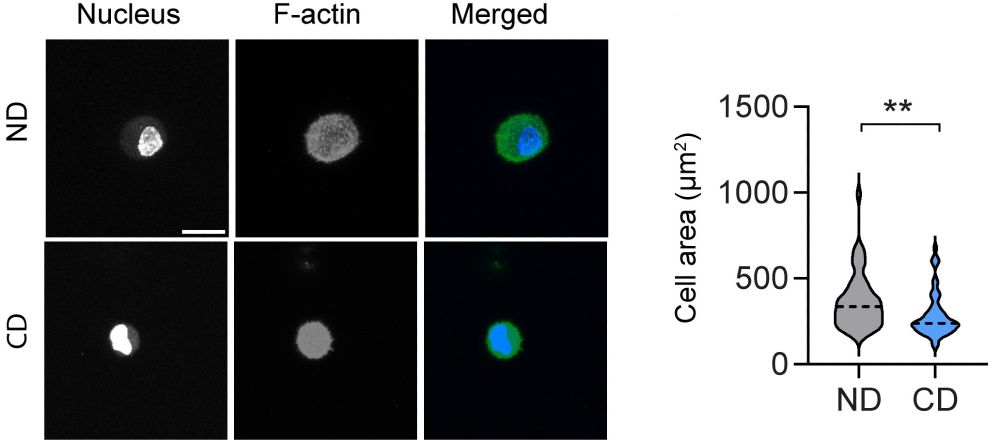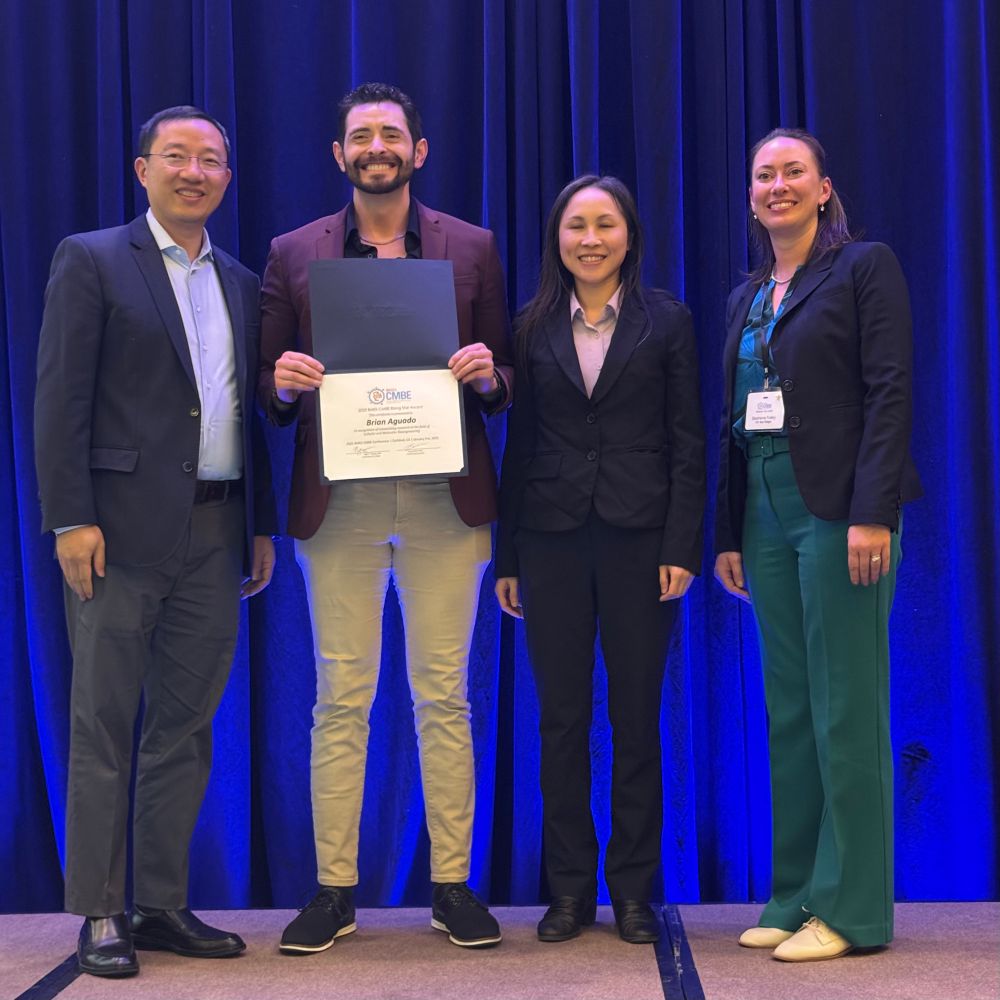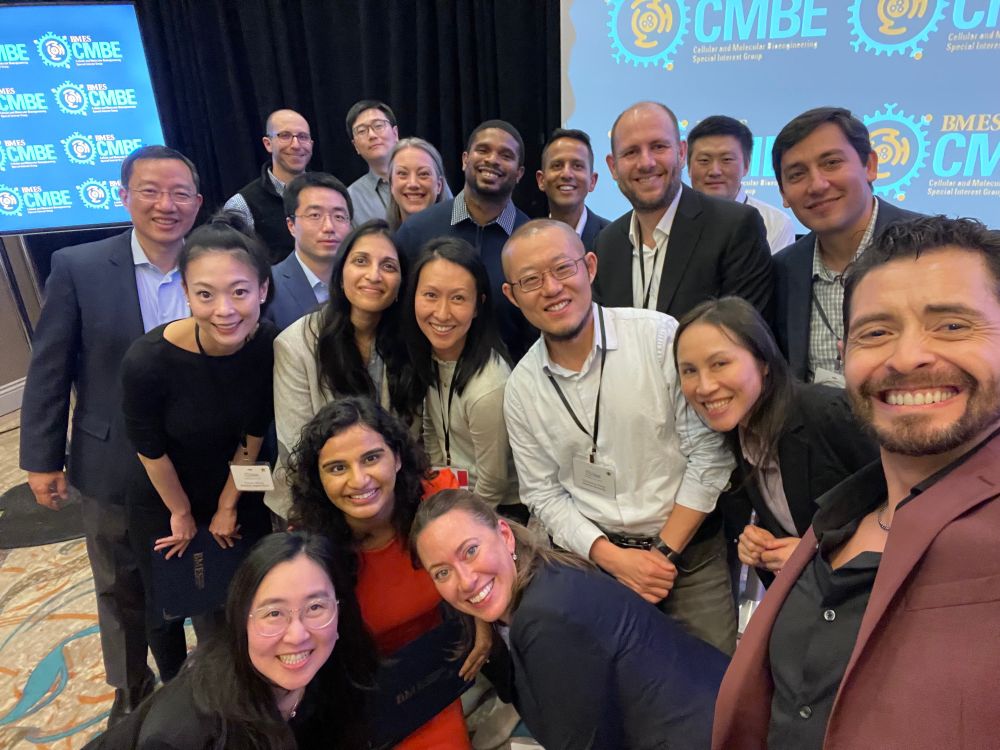This has implications for regenerative medicine, where degradable scaffolds are used to promote cell infiltration and tissue repair. #science #biomaterials @ucsandiego.bsky.social
25.03.2025 21:46 — 👍 0 🔁 0 💬 0 📌 0
Since biomaterial properties are typically assessed post-manufacture without accounting for cellular modification, adjusting for degradation effects will be crucial for engineering biomaterials that sustain desired environmental conditions and regulate cell behavior effectively.
25.03.2025 21:46 — 👍 1 🔁 0 💬 1 📌 0
It also shows that local degradation by cells can result in materials that are biophysically distinct from their initial characterizations.
25.03.2025 21:46 — 👍 1 🔁 0 💬 1 📌 0
This study shows that hydrogel degradability can be used as a design variable to engineer stress relaxation and cellular adhesion, with far-reaching implications for the development of future biomaterials.
25.03.2025 21:46 — 👍 0 🔁 0 💬 1 📌 0

Cells embedded inside these synthetic hydrogels and using their own MMPs showed a similar response, spreading less in the cell-degradable (CD) gels than the non-degradable (ND) gels.
25.03.2025 21:46 — 👍 0 🔁 0 💬 1 📌 0

Cells sensed these MMP-induced changes in stress relaxation, spreading less and forming fewer and smaller focal adhesions.
25.03.2025 21:46 — 👍 0 🔁 0 💬 1 📌 0

To verify that cells were actually sensing the changes in stress relaxation caused by MMPs, we engineered a synthetic hydrogel with MMP-degradable peptides. When treated with increasing amounts of MMPs, its stiffness doesn't change, but it relaxes faster, like the natural ECM.
25.03.2025 21:46 — 👍 0 🔁 0 💬 1 📌 0

Cells sensed the MMP treated ECM, spreading less that they normally do on the untreated ECM.
25.03.2025 21:46 — 👍 0 🔁 0 💬 1 📌 0

and the mechanics of the ECM. Increasing MMPs didn't change the stiffness of the ECM, but did increase its stress relaxing behavior.
25.03.2025 21:46 — 👍 0 🔁 0 💬 1 📌 0

In this study, the incredibly talented @badznithin.bsky.social asked whether the small cuts in the ECM cells make with their MMPs change the mechanics of the environment in a way that cells can feel...a feedback loop! We found that even small amounts of MMPs change the architecture...
25.03.2025 21:46 — 👍 0 🔁 0 💬 1 📌 0

edward scissorhands is holding a pair of scissors in his hand
ALT: edward scissorhands is holding a pair of scissors in his hand
Cells do this in multiple ways, including by using enzymes called matrix metalloproteinases (MMPs) to trim away at their environment, the extracellular matrix (ECM).
25.03.2025 21:46 — 👍 1 🔁 0 💬 1 📌 0
📢Paper alert: Matrix degradation enhances stress relaxation, regulating cell adhesion and spreading | www.pnas.org/doi/10.1073/... 🧵Often our studies focus on how the mechanics of the environment impact cell behavior...but it's a two-way street...cells can also effect changes on their environment...
25.03.2025 21:46 — 👍 4 🔁 1 💬 1 📌 1
This has implications for regenerative medicine, where degradable scaffolds are used to promote cell infiltration and tissue repair.
25.03.2025 21:28 — 👍 0 🔁 0 💬 0 📌 0
Since biomaterial properties are typically assessed post-manufacture without accounting for cellular modification, adjusting for degradation effects will be crucial for engineering biomaterials that sustain desired environmental conditions and regulate cell behavior effectively.
25.03.2025 21:28 — 👍 0 🔁 0 💬 1 📌 0
It also shows that local degradation by cells can result in materials that are biophysically distinct from their initial characterizations.
25.03.2025 21:28 — 👍 0 🔁 0 💬 1 📌 0
This study shows that hydrogel degradability can be used as a design variable to engineer stress relaxation and cellular adhesion, with far-reaching implications for the development of future biomaterials.
25.03.2025 21:28 — 👍 0 🔁 0 💬 1 📌 0

Cells embedded inside these synthetic hydrogels and using their own MMPs showed a similar response, spreading less in the cell-degradable (CD) gels than the non-degradable (ND) gels.
25.03.2025 21:28 — 👍 0 🔁 0 💬 1 📌 0

Cells sensed these MMP-induced changes in stress relaxation, spreading less and forming fewer and smaller focal adhesions.
25.03.2025 21:28 — 👍 0 🔁 0 💬 1 📌 0

To verify that cells were actually sensing the changes in stress relaxation caused by MMPs, we engineered a synthetic hydrogel with MMP-degradable peptides. When treated with increasing amounts of MMPs, its stiffness doesn't change, but it relaxes faster, like the natural ECM.
25.03.2025 21:28 — 👍 0 🔁 0 💬 1 📌 0

Cells sensed the MMP treated ECM, spreading less that they normally do on the untreated ECM.
25.03.2025 21:28 — 👍 0 🔁 0 💬 1 📌 0

and the mechanics of the ECM. Increasing MMPs didn't change the stiffness of the ECM, but did increase its stress relaxing behavior.
25.03.2025 21:28 — 👍 0 🔁 0 💬 1 📌 0

In this study, the incredibly talented @badznithin.bsky.social asked whether the small cuts in the ECM cells make with their MMPs change the mechanics of the environment in a way that cells can feel...a feedback loop! We found that even small amounts of MMPs change the architecture...
25.03.2025 21:28 — 👍 0 🔁 0 💬 1 📌 0

Cells do this in multiple ways, including by using enzymes called matrix metalloproteinases (MMPs) to trim away at their environment, the extracellular matrix (ECM).
25.03.2025 21:28 — 👍 0 🔁 0 💬 1 📌 0


Thank you @bmes-cmbe.bsky.social for the gala dinner last night to celebrate the CMBE Rising Star Awardees! ⭐️ Hoping more of these superstars join BlueSky! @marianhh.bsky.social @rituraman.bsky.social @fraleylab.bsky.social
05.01.2025 17:35 — 👍 14 🔁 5 💬 1 📌 0
Associate Professor | UNC Chapel Hill, Pharmacology Department | Lineberger Comprehensive Cancer Center | Research in Endocrinology, Epigenetics, & Wnt signaling| Views my own. https://www.med.unc.edu/pharm/pruittlab/team/
PhD, Genetics and Molecular Biology // Postdoc - Griffith Lab - MIT BE
GH: https://github.com/DominickHellen
Husband, Father and grandfather, Datahound, Dog lover, Fan of Celtic music, Former NIGMS director, Former EiC of Science magazine, Stand Up for Science advisor, Pittsburgh, PA
NIH Dashboard: https://jeremymberg.github.io/jeremyberg.github.io/index.html
Associate professor in biomedical engineering @VCU developing microphysiological systems to probe cell migration and mechanobiology mechanisms | @duke @washu whitaker alum
AIMBE is a nonprofit organization representing the most accomplished individuals in the fields of medical and biological engineering. Our mission is to provide leadership and advocacy in medical and biological engineering. https://linktr.ee/AIMBEOfficial
I'm just an Alien, standing in front of a country, asking it to let me improve their biotechnology {Algorithms, Protein Sequencing, Drug Discovery, HCI, jokes}
cheme phd in the heilshorn lab @ stanford & chem-h | nsf grfp & nih f31 fellow | formerly mit cheme | just a dancer trying to understand the brain using stem cells & biomaterials!
👩🏻🔬🧠🩰
Weyerhaeuser Associate Professor of Chemical Engineering & Bioengineering, University of Washington | User-Programmable Biomaterials | Photochemistry | Optogenetics | Protein Engineering
http://www.coledeforest.com
Assoc Prof @UW 🏳️🌈. Engineering human organoids, organs, and societies. Views my own. She/her.
Asst Professor of BioEng, UC San Diego | #SexDifferences 🤝 #Biomaterials | LatinXinBME Cofounder | CZI Science Diversity Leader | NIH Director’s New Innovator | WHISDEM Center Co-Director for Women’s Health | 🇨🇴🇺🇸🏳️🌈
https://aguado.eng.ucsd.edu/
Associate Prof. Chemical Engineering at University at Buffalo, SUNY | PI of Systems Biomedicine & Pharmaceutics Lab | We study tissue microenvironments | Computational Scientist | Teacher-Scholar | she/her/hers
We are a biomaterials lab investigating approaches to unlock endogenous regeneration. We have special interest in skin, brain regeneration and culturing tolerance after organ/tissue transplants. Lab website: seguralab@duke.edu.
< https://gerechtlab.duke.edu/ >
Vascular Tissue Engineering | Tumor Microenvironment | Polymeric Biomaterials @ Duke University | Account moderated by SG & students
Lab of Prof. Sanjay Kumar, QB3-Berkeley Director. Dissecting, modeling, and controlling biology with materials & mechanics kumarlab.berkeley.edu
Asst Prof @BostonU BME | Noninvasive biomarkers for cancer monitoring | https://ericaprattlab.com | @prattlab.bsky.social
Tiampo Family Associate Professor at Tufts University, cancer and epilepsy researcher, fierce advocate for diversity and inclusion, mom of a daughter with the SCN8A epilepsy
VP for Research, T.H. Smoot Professor
Depts Chemical and Biomolecular Engn, Pathology, Oncology, INBT
Johns Hopkins University
3D multi-omic, CAR T therapy, cell migration and mechanics
Lab: https://wirtzlab.johnshopkins.edu









